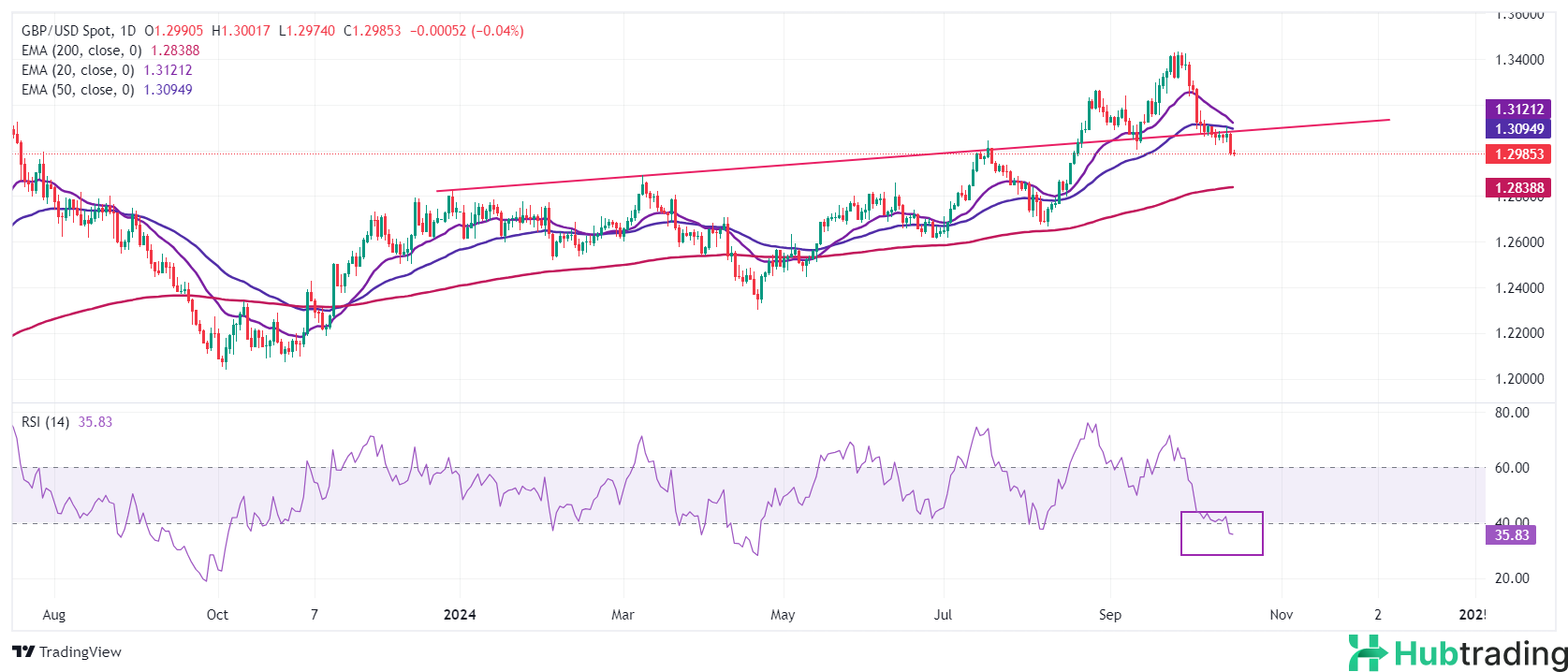- The Pound Sterling is trading below 1.3000 against the US Dollar as declining UK inflation bolsters dovish expectations for the Bank of England.
- UK service inflation has decreased to 4.9%, the lowest since May 2022.
- Increasing speculation about a potential Trump victory in the upcoming US presidential elections has boosted the US Dollar.
The Pound Sterling (GBP) is attempting to recover against its major peers on Thursday after a significant sell-off on Wednesday. The currency dropped sharply following the release of the UK Consumer Price Index (CPI) data for September, which indicated that inflation rose at a slower-than-expected rate.
Annual headline inflation fell to 1.7%, below the Bank of England’s (BoE) target of 2%. The core CPI, excluding more volatile items, increased by just 3.2%, also lower than anticipated. Notably, UK service inflation—a key metric for BoE officials—slowed to 4.9%.
The decline in inflation has strengthened dovish expectations for the BoE. Traders are now pricing in a 25 basis point (bps) interest rate cut at both remaining policy meetings this year, whereas prior to the CPI release, the market had only anticipated a single cut in either November or December.
British Finance Minister Rachel Reeves welcomed the sharp drop in inflation ahead of her first budget presentation scheduled for October 30, believing it would allow for increased spending on development.
Looking ahead, the next significant economic data point for the UK will be the Retail Sales figures for September, set to be released on Friday. This key indicator of consumer spending is expected to show a 0.3% decline after a 1.1% increase in August, while year-on-year growth is projected to be 3.2%, up from 2.5% in August.
Market Movers: Pound Sterling Remains Under Pressure Against US Dollar
- The Pound Sterling bears are momentarily pausing after dipping to around 1.2970 against the US Dollar in Thursday’s London session. However, the outlook for the GBP/USD pair remains precarious as the US Dollar continues to strengthen, with traders reevaluating expectations of significant Federal Reserve (Fed) rate cuts in November.
- The US Dollar Index (DXY), which measures the Greenback against six major currencies, has reached a fresh 10-week high near 103.60. Market participants are no longer expecting the Fed to pursue aggressive rate cuts, especially after September's US labor market data indicated resilience.
- According to the CME FedWatch tool, market pricing suggests that the Fed is expected to implement a 25 basis point rate cut in both November and December meetings.
- Additionally, rising speculation about former President Donald Trump’s potential victory in the upcoming US presidential elections on November 5 has further bolstered the US Dollar, with investors anticipating looser financial conditions, higher import tariffs, and tax cuts under a Trump administration.
- In the US session on Thursday, investors will closely monitor the monthly US Retail Sales data for September, a key indicator of consumer spending, which will be released at 12:30 GMT. Economists expect a 0.3% increase in retail sales.
Technical Analysis: Pound Sterling Trades Below 1.3000

The Pound Sterling is currently trading below the psychological level of 1.3000 against the US Dollar during London trading hours. The GBP/USD pair weakened after breaking below a four-day trading range of 1.3020 to 1.3100. The currency was already under pressure after slipping beneath an upward trendline drawn from the December 28, 2023 high of 1.2827 earlier in October.
The near-term outlook for the pair appears vulnerable, with the 20- and 50-day Exponential Moving Averages (EMAs) near 1.3135 and 1.3100, respectively, both trending downward. Additionally, the Relative Strength Index (RSI) has recently dipped below 40.00, indicating increasing bearish momentum.
On the downside, the 200-day EMA around 1.2840 will serve as a critical support level for Pound Sterling bulls. Conversely, the pair will encounter resistance near the psychological level of 1.3100 on the upside.





